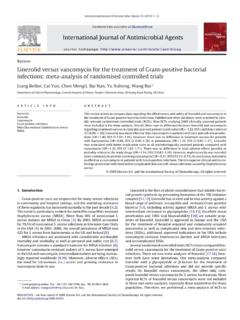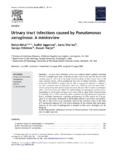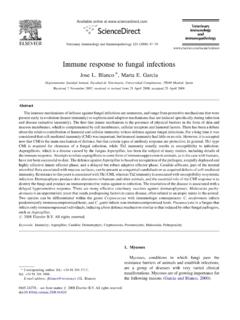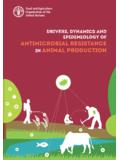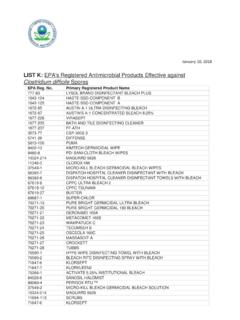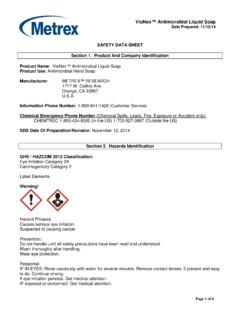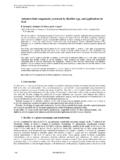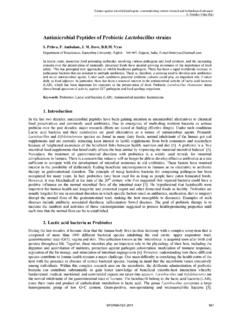Transcription of Review Antimicrobial activity of flavonoids
1 International Journal of Antimicrobial Agents 26 (2005) 343 356 ReviewAntimicrobial activity of Tim Cushnie, Andrew J. Lamb School of Pharmacy, The Robert Gordon University, Schoolhill, Aberdeen AB10 1FR, UKAbstractFlavonoids are ubiquitous in photosynthesising cells and are commonly found in fruit, vegetables, nuts, seeds, stems, flowers, tea, wine,propolis and honey. For centuries, preparations containing these compounds as the principal physiologically active constituents have beenused to treat human diseases. Increasingly, this class of natural products is becoming the subject of anti-infective research, and many groupshave isolated and identified the structures of flavonoids possessing antifungal, antiviral and antibacterial activity .
2 Moreover, several groupshave demonstrated synergy between active flavonoids as well as between flavonoids and existing chemotherapeutics. Reports of activityin the field of antibacterial flavonoid research are widely conflicting, probably owing to inter- and intra-assay variation in susceptibilitytesting. However, several high-quality investigations have examined the relationship between flavonoid structure and antibacterial activityand these are in close agreement. In addition, numerous research groups have sought to elucidate the antibacterial mechanisms of action ofselected flavonoids. The activity of quercetin, for example, has been at least partially attributed to inhibition of DNA gyrase.
3 It has also beenproposed that sophoraflavone G and ( )-epigallocatechin gallate inhibit cytoplasmic membrane function, and that licochalcones A and Cinhibit energy metabolism. Other flavonoids whose mechanisms of action have been investigated include robinetin, myricetin, apigenin, rutin,galangin, 2,4,2 -trihydroxy-5 -methylchalcone and lonchocarpol A. These compounds represent novel leads, and future studies may allow thedevelopment of a pharmacologically acceptable Antimicrobial agent or class of agents. 2005 Elsevier and the International Society of Chemotherapy. All rights :Flavonoids; Antifungal; Antiviral; Antibacterial; Structure activity ; Mechanism of action1.
4 IntroductionResistance to Antimicrobial agents has become an increas-ingly important and pressing global problem. Of the 2 millionpeople who acquire bacterial infections in US hospitals eachyear, 70% of cases now involve strains that are resistant to atleast one drug[1]. A major cause for concern in the UK ismethicillin-resistantStaphylococcus aureus(MRSA), whichwas at low levels a decade ago but now accounts for ca. 50% ofallS. aureusisolates[2]. Substantial investment and researchin the field of anti-infectives are now desperately needed if apublic health crisis is to be modification of Antimicrobial drugs to whichresistance has developed has proven to be an effective meansof extending the lifespan of antifungal agents such as theazoles[3], antiviral agents such as the non-nucleoside reversetranscriptase inhibitors[4], and various antibacterial agents Corresponding author.
5 Tel.: +44 1224 262 526; fax: +44 1224 262 ( Lamb).including -lactams and quinolones[5]. It is not surprisingthen, that in response to Antimicrobial resistance, major phar-maceutical companies have tended to concentrate their effortson improving Antimicrobial agents in established classes[6].However, with the portfolio of chemotherapeutics currentlyavailable, it has been acknowledged that researchers are get-ting close to the end game in terms of parent structure alter-ations. A call has therefore been made for the developmentof new classes of drug that work on different target sites tothose in current use[7,8].Rational drug design does not always yield effectiveantimicrobials.
6 In the past, potent enzyme inhibitors havebeen successfully designed and synthesised but they had onlymodest antibacterial activity , probably owing to the com-plex issue of drug uptake by cells. Broad empirical screen-ing of chemical entities for Antimicrobial activity representsan alternative strategy for the development of novel products have been a particularly rich source ofanti-infective agents, yielding, for example, the penicillinsin 1940, the tetracyclines in 1948 and the glycopeptides in0924-8579/$ see front matter 2005 Elsevier and the International Society of Chemotherapy. All rights Cushnie, Lamb / International Journal of Antimicrobial Agents 26 (2005) 343 3561955[9].
7 The following Review will examine the antimi- crobial activity of flavonoids, a class of natural productspossessing a diverse range of pharmacological with antifungal, antiviral and antibacterial activ-ity will each be discussed in turn, with particular emphasison those flavonoids with antibacterial Flavonoids: occurrence, functions, structure andnomenclatureFlavonoids are ubiquitous in photosynthesising cells andtherefore occur widely in the plant kingdom[10]. They arefound in fruit, vegetables, nuts, seeds, stems and flowers aswell as tea, wine[11], propolis and honey[12], and representa common constituent of the human diet[13].
8 In the US,the daily dietary intake of mixed flavonoids is estimated tobe in the range 500 1000 mg, but this figure can be as highas several grams for people supplementing their diets withflavonoids or flavonoid-containing herbal preparations[14].The function of flavonoids in flowers is to provide coloursattractive to plant pollinators[11,15]. In leaves, these com-pounds are increasingly believed to promote physiologi-cal survival of the plant, protecting it from, for example,fungal pathogens and UV-B radiation[13,15]. In addition,flavonoids are involved in photosensitisation, energy transfer,the actions of plant growth hormones and growth regulators,control of respiration and photosynthesis, morphogenesis andsex determination[11,13].
9 The basic structural feature of flavonoid compounds is the2-phenyl-benzo[ ]pyrane or flavane nucleus, which consistsof two benzene rings (A and B) linked through a heterocyclicpyrane ring (C) (Fig. 1)[16]. Flavonoids can be classifiedaccording to biosynthetic origin. Some classes, for exam-ple chalcones, flavanones, flavan-3-ols and flavan-3,4-diols,are both intermediates in biosynthesis as well as end prod-ucts that can accumulate in plant tissues. Other classes areonly known as end products of biosynthesis, for exampleanthocyanidins, proanthocyanidins, flavones and additional classes of flavonoid are those in which the2-phenyl side chain of flavanone isomerises to the 3 posi-tion, giving rise to isoflavones and related isoflavonoids.
10 TheFig. 1. The skeleton structure of the flavones (a class of flavonoids), withrings named and positions numbered[13].neoflavonoid is formed through further isomerisation to the 4position[13]. Structures of the major classes of flavonoids aregiven inFig. 2. The structures of specific compounds withinthese classes that possess Antimicrobial activity and that arediscussed in the present Review are summarised inTable flavonoids may be assigned names in three dif-ferent ways. Trivial names are employed extensively andsometimes indicate flavonoid class or plant source. For exam-ple, names ending in inidin can denote an anthocyanidin,names ending in etin generally denote a flavonol, andcompounds tricin and hypolaetin have been extracted fromplants belonging to the may also be named in a semi-systematic man-ner based on trivial names such as flavone or chalcone asthe parent structure, 3,5,7,3 4 -pentahydroxyflavone or3,3 ,4 ,5,7-pentahydroxyflavone.
